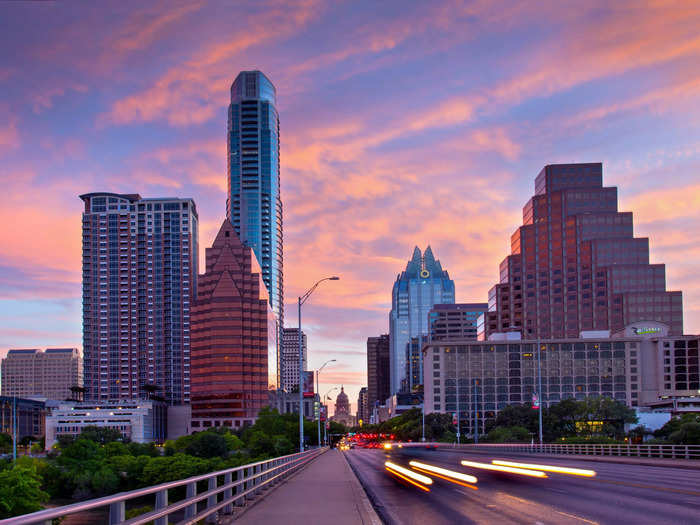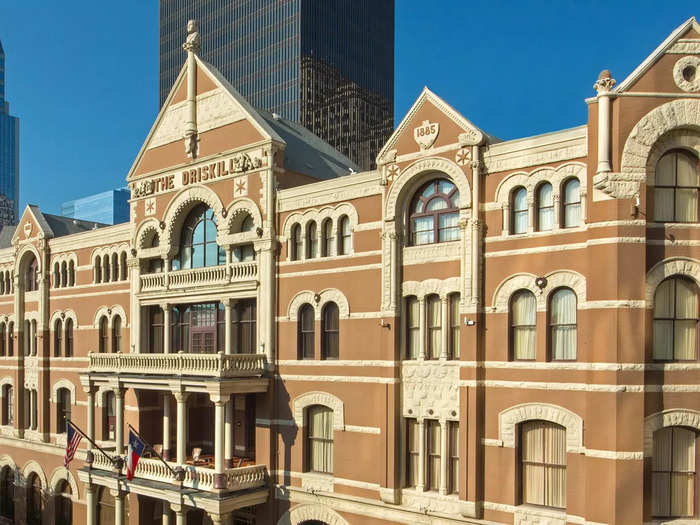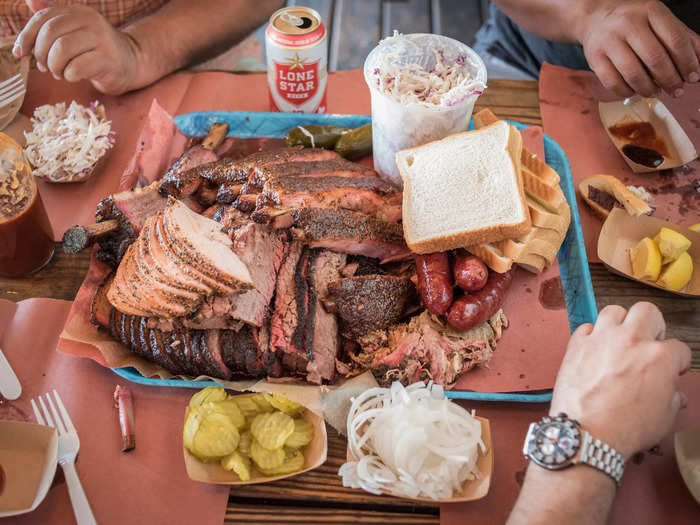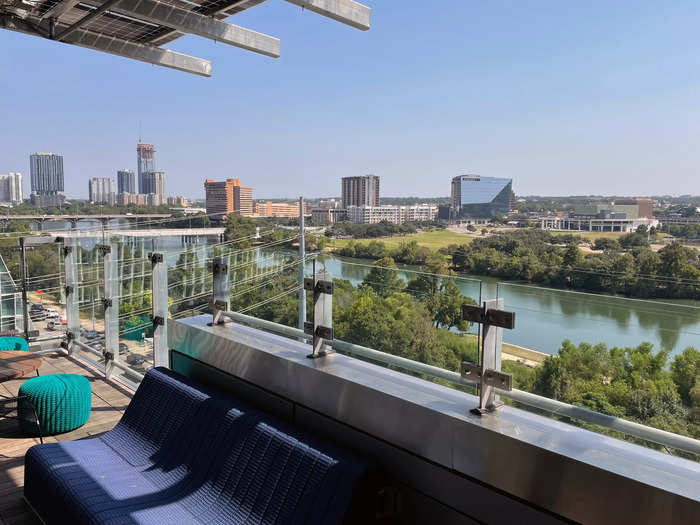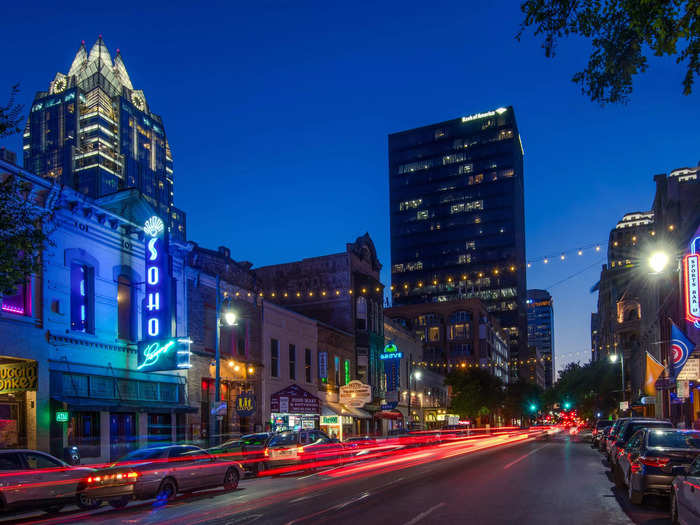Austin is home to the Texas capital, the University of Texas, and an expanding list of celebrity residents.dszc/Getty Images
- Austin is a bustling metropolitan known for its quirky personality and lively culture.
- There are many hotel, restaurant, and activity options when planning a trip to the Texas capital.
What started as a small riverside town in Texas has grown into a bustling metropolitan area popular for its distinct liberal culture, affinity for live music, quirky personality, and quickly expanding list of celebrity residents.
There's something about the energy of Austin - Texas' capital and home of the University of Texas - that permeates visitors, inviting them to enjoy the simplicity of life in Texas with benefits like a well-established culinary scene, lively music, and arts culture, and an appreciation for and preservation of nature.
Above all else, it's the city's weirdness that draws people in. Whether it's Matthew McConaughey getting arrested while playing the bongos naked, or dozens of couples and families watching the largest urban bat colony in the world leave the South Congress Bridge at sunset, there's something a little off about the everyday happenings in Austin that makes it an intriguing destination.
In the past decade, Austin's population grew by 21%, solidifying it as Texas' second-fastest-growing major city. This boom has helped the already interesting city grow into a tourist destination with even more one-of-a-kind restaurants, bars, activities, and sites to see.
No matter your vibe - hipster, haute, hippie, or humble - there's something for everyone in Bat City.
Despite the massive growth, the influx of tech companies, and the continuous construction, shades of Austin's small-town origins help make the city exciting, fun, and, yes, a little weird.
Getting to Austin
Congress Avenue Bridge crosses over the city's Lady Bird Lake.
Congress Avenue Bridge crosses over the city's Lady Bird Lake.
From the steaks to the heat index to the area (nearly 270,000 square miles), Texas certainly lives up to its reputation of being big and bold. Texas is the second-largest US state — it is so large, in fact, that it takes about 12 to 14 hours to drive across it. Depending on where you're traveling from, flying is probably the best way to visit Austin (unless, of course, you're ready for a long road trip).
If you choose to fly, you'll land at Austin-Bergstrom International Airport, about 5 miles from downtown. Though smaller than most international airports, Austin-Bergstrom is big in charm and personality. The airport features art by local artists, a slew of local restaurants, and, often, performances by singer-songwriters who greet passengers as they enter the live-music capital. The airport says it coordinates with Austin Public Health to monitor the COVID-19 pandemic and make adjustments and recommendations as necessary. Be sure to check your airline's guidelines and requirements before traveling.
Travelers can get a taste of Austin before they even leave the airport by enjoying local favorites such as Salt Lick BBQ, Tacodeli (a must for early-flight breakfast tacos), Annie's Bar & Cafe, and Amy's Ice Creams. After you grab a bite to eat, a 15-minute ride (pending traffic) on State Highway 71 will get you to the heart of downtown Austin. You can rent a car, use ride-hailing services like Uber, Lyft, and Wingz, or take a cab (fares begin at $13.80).
Regardless of where you're staying, it's best to plan for how you want to get around the sprawling city. Generally, a car is the best way to travel, particularly in the Texas heat. Uber and Lyft surge pricing can get out of hand on nights and weekends, but many other ride-hailing options are available.
If you're keeping your Austin adventures to downtown and nearby popular areas like South Congress or Rainey Street, you can walk, rent a bike, take the bus, or hail a pedicab — if the weather isn't too sweltering. In addition, you can hop on one of the electric scooters sprinkled all over the city. But riders beware: Locals have complicated feelings about e-scooters. So follow traffic laws and park your scooter respectfully when you're done.
Whichever travel method you choose, plan for traffic. Austin is one of the nation's fastest-growing cities, and, as a result, it has more people, cars, and other forms of transportation than ever. Though much of Austin's attractions are within 15 to 30 minutes of downtown, budget an extra half-hour during peak travel times — like rush hours, holidays, and events — to get to your reservations on time.
Where to stay in Austin
Opened in 1886, the historic Driskill Hotel is a short walk from the Texas State Capitol and the Austin Convention Center.
Courtesy of The Driskill
Finding the right part of town and ideal accommodations are key to setting the mood for your trip to Austin.
If you're hoping to branch out from touristy spots like the South Congress district, consider spending a weekend like a true Austin native in Hyde Park. One of the oldest neighborhoods in Austin, Hyde Park features tree-lined streets with charming and historic homes. You can enjoy the architecture while taking a walk to Austin institutions like Hyde Park Bar & Grill, Antonelli's Cheese Shop, and Quack's 43rd Street Bakery. Other neighborhoods worth checking out for an authentic "old Austin" feel include Travis Heights and Barton Hills.
For an elegant stay that keeps you connected to the happenings downtown, check out the Kimpton Hotel Van Zandt in the Rainey Street district. The hotel features decadent amenities and is within walking distance of Rainey Street's trendy bars and restaurants.
Those interested in a more luxurious retreat should visit Miraval Austin or Lake Austin Spa Resort, both of which offer an array of spa services and wellness activities. They're further removed from downtown, allowing for maximum relaxation and enjoyment of Austin's natural beauty.
Downtown Austin's oldest hotel, The Driskill, gives travelers the perfect mix of local history and easy access to the city's biggest entertainment district, Sixth Street. The hotel's rich history — it opened in 1886 — leads many to say it's haunted. Skeptical? Book a room, take a ghost tour, and see for yourself.
Travelers interested in camping in tents, vans, or RVs should reserve a spot at McKinney Falls State Park. Once you see the park's limestone waterfalls and enjoy a nature walk on one of the many hiking trails, you'll be surprised to learn that you're only about 10 miles from the city's center.
What to eat in Austin
People come from all over the country to try Franklin Barbecue.
Wyatt McSpadden
There may be a battle between the residents of old Austin and the newcomers flocking to the city, but all Austinites can agree that the city is home to some of the best restaurants and bars in the country.
You can't talk Texas without mentioning barbecue, and Austin certainly has some of the most legendary eateries. There's Franklin Barbecue, which might require standing in line for hours to enjoy — but don't think it's the only good 'cue in town. A 30-minute drive out to Driftwood will take you to The Salt Lick, a half-century-old Austin icon with recipes originating from the late 1800s. Diners can watch as the smoked meat gets basted in the restaurant's iconic open pit and eat surrounded by sprawling oak trees.
Austin is home to some amazing Mexican restaurants, many of which have been in business for decades. Some local favorites include Matt's El Rancho, Fonda San Miguel, and the original Chuy's on Barton Springs.
Looking for a more elegant or unique dining experience? Consider making reservations at Barley Swine, Odd Duck, Uchi, or Lenoir.
For a snack, visit Antonelli's Cheese Shop in historic Hyde Park. This husband-and-wife-owned shop features over 100 types of artisan and international cheeses that can be sampled, cut to order, and even shipped home. Antonelli's also hosts public and private cheese classes and tastings for a unique food experience.
For a coffee break or for those with a sweet tooth, head to Mozart's, a favorite coffee shop and bakery that features live music and a patio with must-see views of Lake Austin.
For a nightcap, try the Firehouse Hostel and Lounge, a craft-cocktail bar that also happens to be a hostel. Located in Austin's oldest standing fire station, Firehouse offers live jazz, blues, and rock.
Activities in Austin
The tranquil rooftop garden at the Austin Central Public Library features lush foliage, seating and reading areas, and a large deck. Overlooking downtown and Lady Bird Lake, the rooftop garden is the ideal location to take in beautiful city and nature views.
Kirstie Renae for Insider
Whether your travel interests lie in hearing live music, dining, drinking, dancing, sightseeing, or experiencing nature, there's something for you in Austin.
Affectionately known as the live-music capital of the world, Austin has an array of venues to choose from. From the Saxon Pub to Stubb's to Antone's and beyond, there's music throughout the city. But if you're in the mood for live performances of comedy, magic, or satire, check out Esther's Follies on Sixth Street.
If experiencing some Texas two-stepping is on your list, visit Broken Spoke, the self-proclaimed "last of the true Texas dancehalls" and an authentic honky-tonk. Country legends like Garth Brooks, Dolly Parton, Willie Nelson, and George Strait have performed there; you can see their legacy in the venue's memorabilia room. Dance lessons are also available for newbies.
Enjoy a round of golf and some beer at the historic Butler Park Pitch and Putt, near Town Lake. Not a golf pro? Let your inner child out by mini-golfing at Peter Pan, a family-owned, BYOB putt-putt course that's as quirky as Austin itself. If an indoor activity is more your speed, head to the Texas Union Underground for glow-in-the-dark bowling.
For artistic travelers, a must-see is Ellsworth Kelly's "Austin", a 2,715-square-foot stone-and-colored-glass installation at the Blanton Museum of Art. Afterward, drive 15 minutes to the Umlauf Sculpture Garden & Museum, a 6-acre garden with more than 50 sculptures surrounded by native plants.
Nature lovers can see wild peacocks at Mayfield Park and Nature Preserve, enjoy panoramic views at the top of Mount Bonnell or the 360 Overlook, and follow the Ann and Roy Butler Hike-and-Bike Trail at Lady Bird Lake (while you're there, consider paddleboarding or kayaking). If it's too hot for those activities, visit the nearby Central Library, which includes six floors of books and educational materials, a cookbook bar and café, stunning views of the lake, and a rooftop garden.
Advisories to know before traveling to Austin
Sixth Street is one of Austin's most iconic spots, home to an array of nightlife and entertainment.
John Coletti/Getty Images
Austin Public Health provides a detailed, color-coded COVID-19 risk chart that outlines safety recommendations for vaccinated and unvaccinated people, including which activities — indoor or outdoor — to avoid, as well as advice on the situations that would merit wearing a mask.
Before you visit, check the Austin government's website to determine which stage of its risk-based guidelines the city is in. Austin moved to stage four on September 28, which means fully vaccinated people are advised to wear masks in indoor settings, including dining and shopping, while unvaccinated people are advised to avoid private gatherings.
Texas may be conservative, but Austin is known as a blue dot in a sea of red. Despite Gov. Greg Abbott's recent order banning government-imposed mask mandates and other restrictions, several Austin businesses and events have prioritized public health by enforcing special protocols.
Many restaurants, stores, and activities in Austin require masking regardless of the city's risk stage. In addition, proof of vaccination or a negative COVID-19 test may be required for entry to concert venues like ACL Live and large events like the famed music festival Austin City Limits. Before planning activities or purchasing tickets, check with local establishments to understand their requirements.

